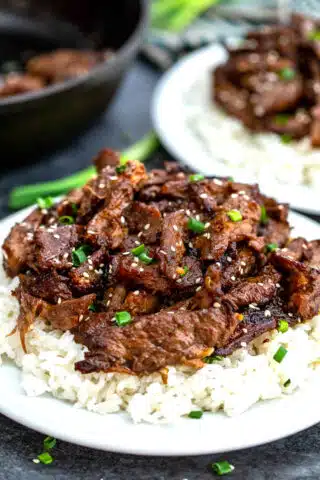Hunan Chicken
Making my authentic Hunan Chicken is something I truly enjoy whenever I’m craving flavorful Chinese food. With tender chicken, crisp vegetables, and a spicy Hunan sauce, this dish is ready in just 30 minutes. I love that I can skip the takeout and serve a homemade meal that’s full of bold flavor, made with high quality ingredients.
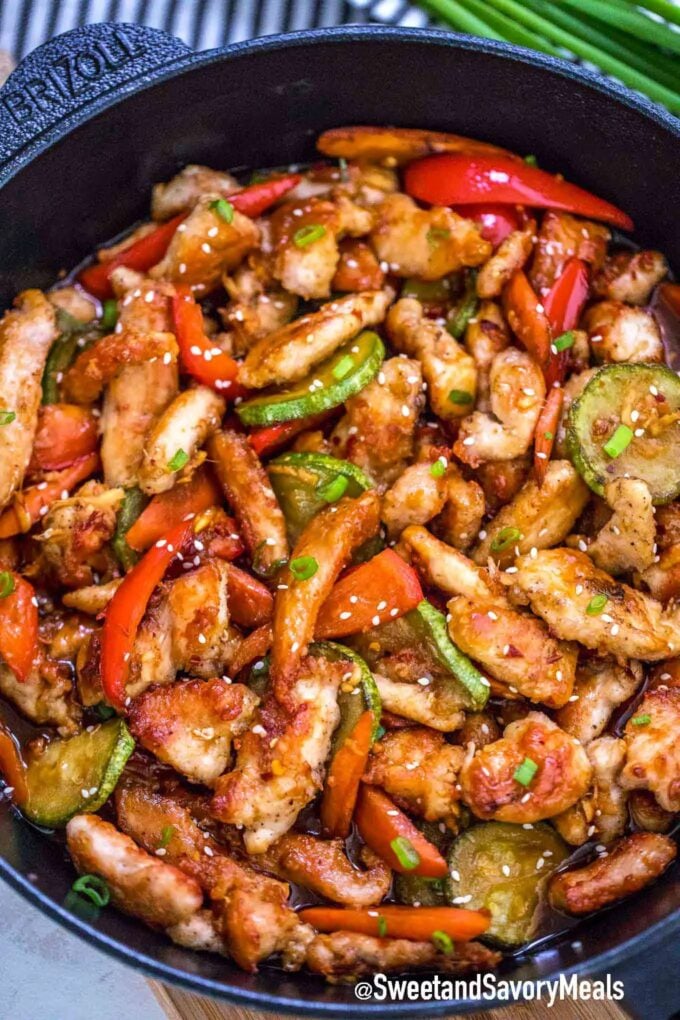
Living in NYC for over a decade, I had my fair share of Chinese take-out. That’s what sparked my personal mission to track down the most authentic and flavorful Chinese food in the city. I still remember the day I had the most delicious Hunan Chicken at a small family-run restaurant tucked into a quiet corner of Chinatown – it was bold, spicy, and unforgettable. That dish inspired me to make it at home with high quality ingredients. Along the way, I also found myself experimenting with other favorites, like my Szechuan Chicken, which brings a different kind of heat with its signature peppery bite.
Table of contents
Using my cooking experience, I’ve fine-tuned this Hunan chicken recipe to stay true to the original while making it easy and approachable for home cooks. Honestly, I think my version is even better, and I’m excited to share exactly why this might become your go-to Chinese dish made right in your own kitchen.

Why you will love this recipe
- Faster than takeout and way more satisfying: I can make this in about 30 minutes, which is usually quicker than waiting on delivery. It’s just as tasty, way fresher, and definitely more budget-friendly.
- I get to pick every ingredient: I like being in charge of what goes into my food, from the oil to the chicken and all the crunchy veggies. No mystery ingredients here, just real food that tastes great.
- Spice it up or keep it mellow: I get to control the heat and the flavor, which is perfect for my family. Sometimes I load up the chili paste, other times I go easy and just pile on more fresh vegetables.
- Tender chicken that actually stays juicy: I use a simple velveting technique to keep the chicken soft inside and crispy outside without deep frying. It’s still got that great texture, just a little lighter and better for everyday meals.
What you’ll need
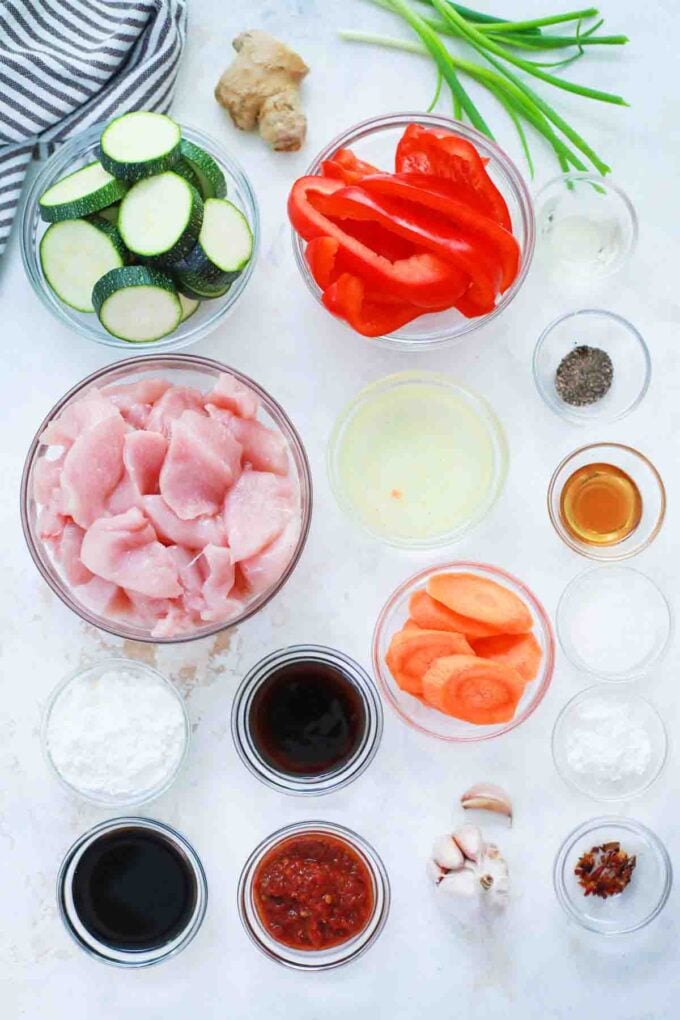
For the chicken and vegetables:
- Chicken and oil – I use boneless chicken breasts, sliced into thin strips so they cook quickly and stay tender. For stir-frying, I go with vegetable oil, but canola or peanut oil also work great.
- Veggies and heat – This recipe gets its color and crunch from red bell pepper, zucchini, and carrots. I also throw in a few chili peppers for a touch of heat and sometimes sprouted black beans for extra depth, though they’re totally optional.
- Seasonings – A quick mix of salt and pepper seasons the chicken before it hits the pan, and a dusting of cornstarch helps give it that crispy edge.
For the sauce:
- Sauce base – I start with soy sauce, oyster sauce, rice wine, and a bit of low sodium chicken broth to build that savory flavor.
- Aromatics and heat – Garlic and fresh ginger add sharp, fragrant depth, while chili paste and red pepper flakes bring just the right amount of spice.
- Sweetness and thickener – A little granulated sugar balances the heat, and cornstarch helps thicken the sauce to that perfect glossy finish.
- Finishing touch – A splash of sesame oil at the end adds a toasty aroma.
How to make
Make the sauce: I always like to mix the sauce ahead of time so it’s ready to go when I start cooking. In a bowl or jar, I combine the garlic, ginger, soy sauce, oyster sauce, sugar, salt, cornstarch, and chili paste. Then I pour in the rice wine and broth, and stir until the cornstarch is completely dissolved. This only takes a few minutes and can even be done the day before to save time.
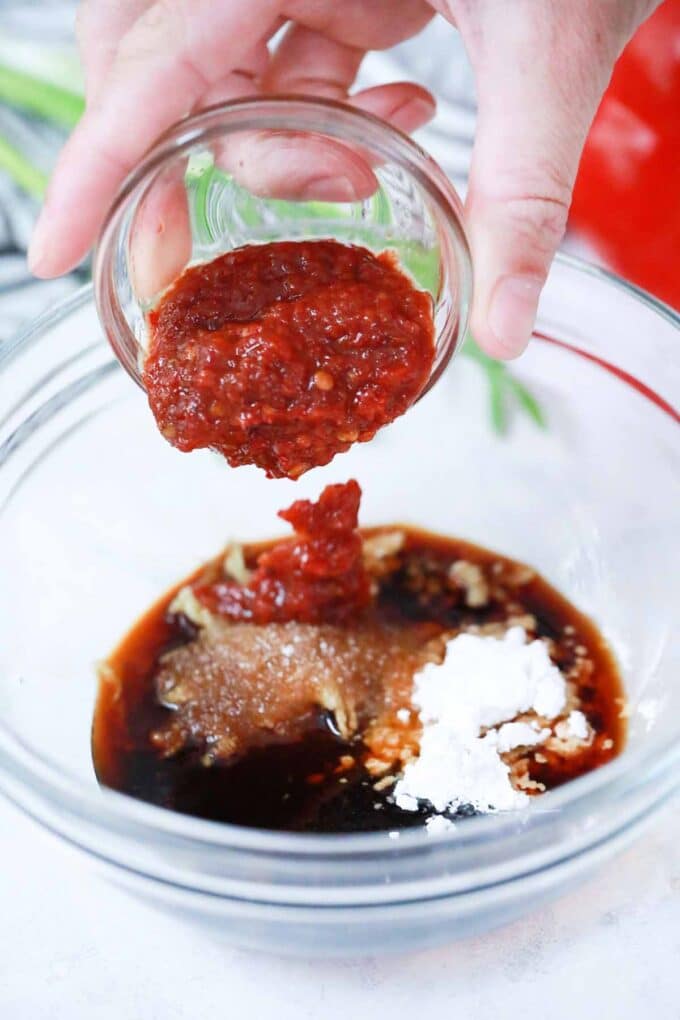
Give the chicken a quick toss in coating: When I’m ready to start cooking, I add the chicken pieces to a large bowl and toss them with cornstarch, salt, and pepper.

Cook the chicken until it’s golden: Once the chicken is coated, I cook it in a hot skillet with vegetable oil until the pieces are golden and cooked through. Then I take them out and set them aside so they stay tender while I finish the rest of the dish.
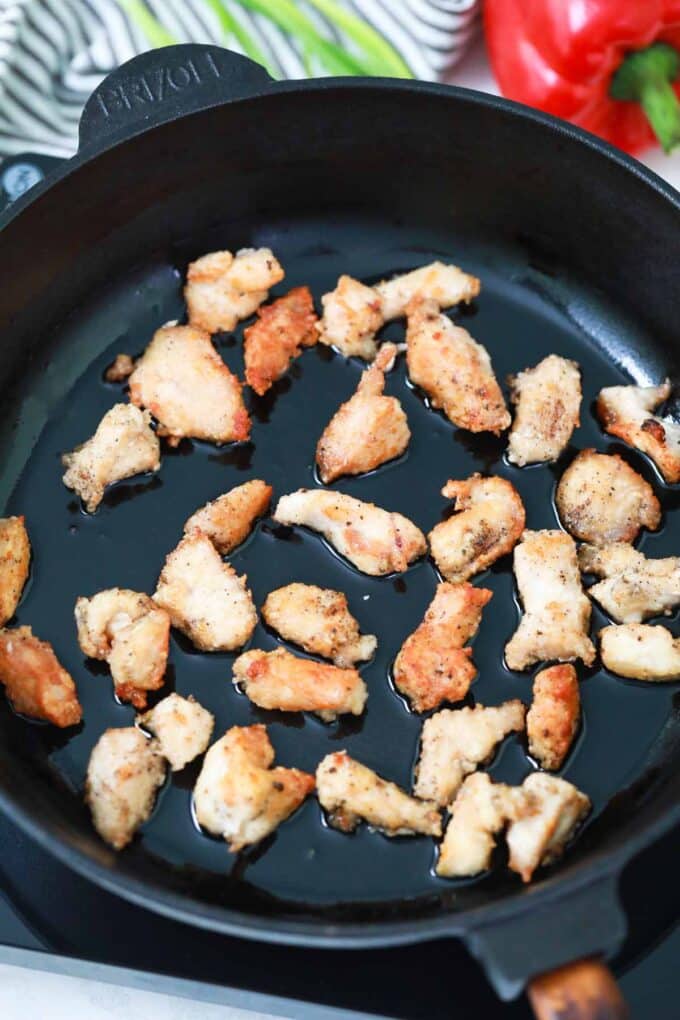
Time to sauté those veggies: Next, I add a little more oil to the pan and toss in the veggies. I cook them until they’re tender but still have a nice crisp bite.
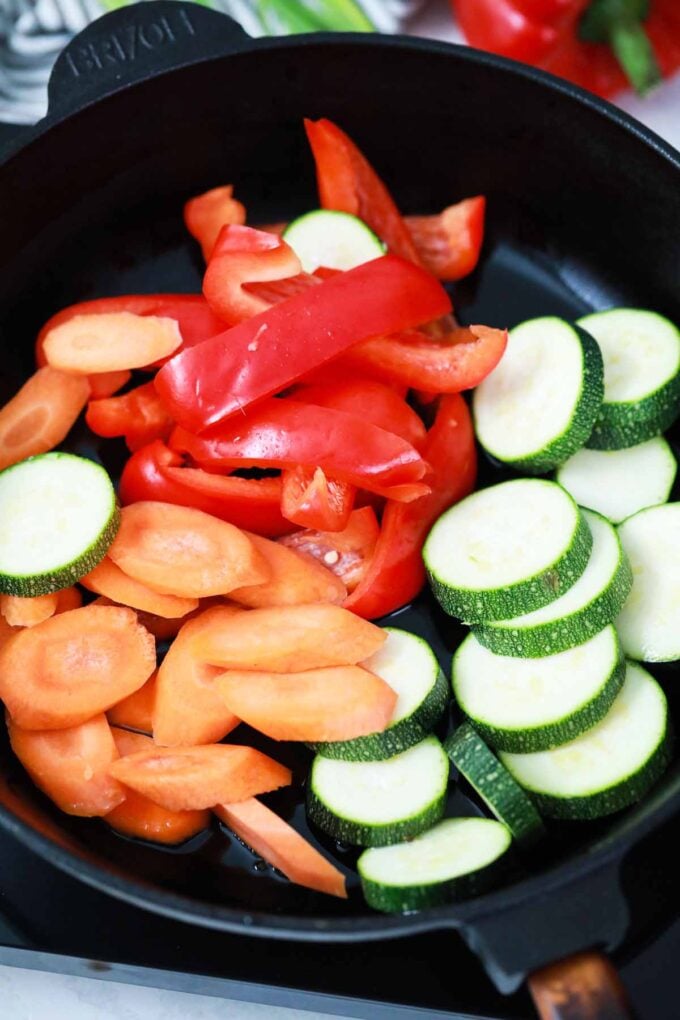
Bring it all together in the pan: I add the chicken back into the pan, give the sauce one last stir, and pour it over the veggies. Then I stir everything for a couple of minutes until the sauce thickens and the chicken is warmed through and coated in all that flavor.

Serve it up while it’s hot: This dish is best served warm, straight from the pan. It’s one of those meals where everyone always goes back for seconds – sometimes thirds.
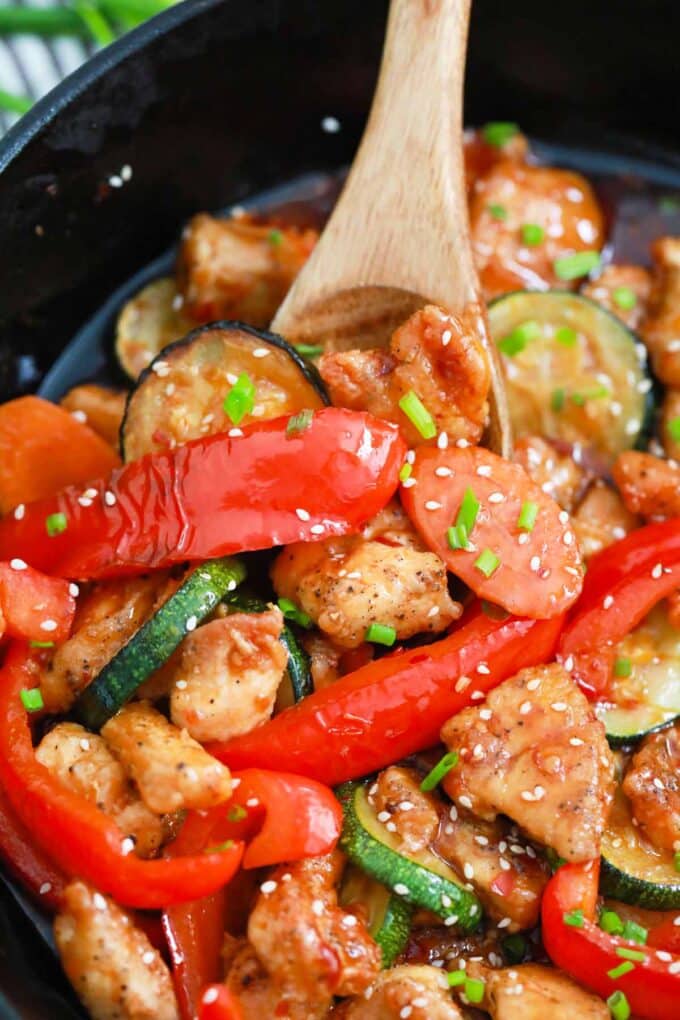
Expert tip
No more dry chicken
Velveting is one of those techniques I learned along the way that completely changed how I cook stir-fry. It’s a simple method that helps keep the chicken tender and juicy while adding a light crisp texture on the outside. Traditionally, it involves coating the meat in egg white, oil, cornstarch, and sometimes a splash of rice wine before blanching it. But to keep things easy in this recipe, I just toss the raw chicken in cornstarch before browning it. It still gives that soft, velvety bite without all the extra steps, and it’s one of the reasons this dish turns out so good every time.
More tips to consider:
- I like to make the sauce ahead and freeze it in small Ziploc bags. That way, I always have some ready to go when I need a quick dinner.
- To slice the chicken thinly and evenly, I freeze it for about 20 to 30 minutes first. It firms up just enough to make slicing easier.
- I always cook the chicken in batches to keep it from steaming. Giving it space in the pan helps it get that nice golden crust.
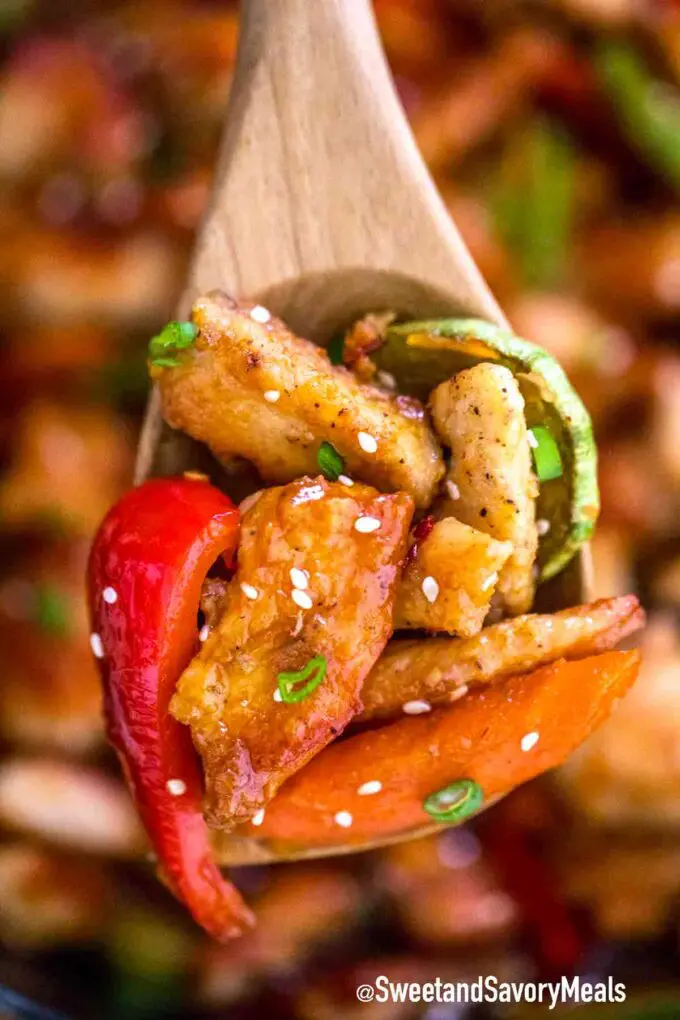
Recipe variations and add-ins
- Meat: I’ve made this recipe with thinly sliced beef and pork, and it works just as well. About one pound of either meat is perfect for swapping in place of the chicken. My Hunan beef recipe is equally delicious.
- Vegetarian: To make it vegetarian, I like using one block of firm tofu or about 8 ounces of tempeh. I also load it up with extra veggies to make it hearty and satisfying.
- Gluten-Free: I swap the soy sauce with coconut aminos or tamari. Just use the same amount as the recipe calls for.
- Veggies: Sometimes I change up the veggies depending on what I have. About 2 to 3 cups of baby corn, mushrooms, green beans, or even bamboo shoots make great add-ins.
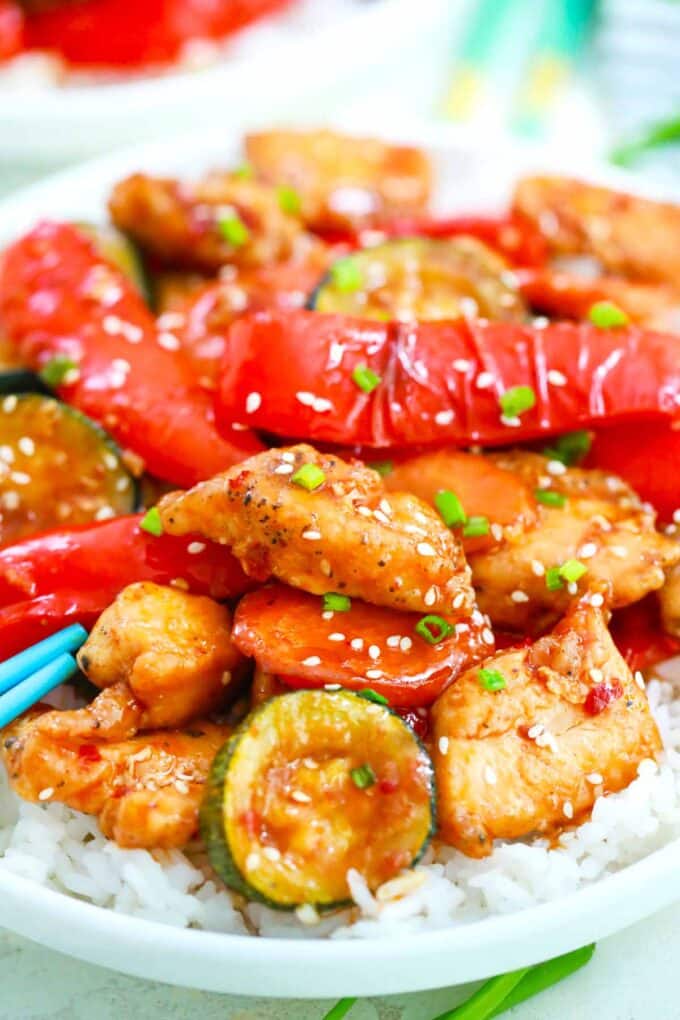
Serving suggestions
This classic Chinese stir-fry is perfect over a bowl of warm steamed rice or with a side of soba noodles to catch all that flavorful sauce. When I want to turn dinner into more of a takeout-style spread, I’ll add some crispy chicken egg rolls or a plate of my shrimp fried rice.
If I’m feeding a group or planning a themed dinner night, I like serving this with my spicy cucumber salad for something fresh and cool. A batch of crispy crab cakes on the side never lasts long, they’re always the first to go.
How to store leftovers
- Fridge: If I end up with leftovers, which rarely happens, I spoon them into a sealed container and keep them in the fridge. They stay fresh for about 3 to 4 days.
- Freeze: This recipe freezes very well. First, let the dish fully cool, and then add it to a freezer-safe container or Ziploc bag. After that, freeze for up to 3 months.
- Defrost: When I’m ready to serve frozen leftovers, I either let them thaw in the fridge overnight or use the microwave to defrost. Then I heat everything in a skillet over medium-high, give it a quick stir-fry, and taste to see if it needs a little extra seasoning before serving.
Frequently Asked Questions
The spiciness of this dish really depends on how much heat you enjoy. I like it with a good amount of chili paste for that classic Hunan-style warmth, but if you’re cooking for kids or someone who prefers it milder, you can easily cut back. You’re still going to get all the flavor thanks to the garlic, ginger, and sauces. The great thing is, you’re in full control of the spice level.
Yes, I have used frozen veggies when I am short on time or out of fresh ones. I just make sure to cook off any extra moisture so the stir-fry stays crisp and saucy.
If I am out of chili paste, I mix a little sriracha with minced garlic or even use a spoonful of chili garlic sauce. It still gives the dish a nice heat and flavor without missing a beat.
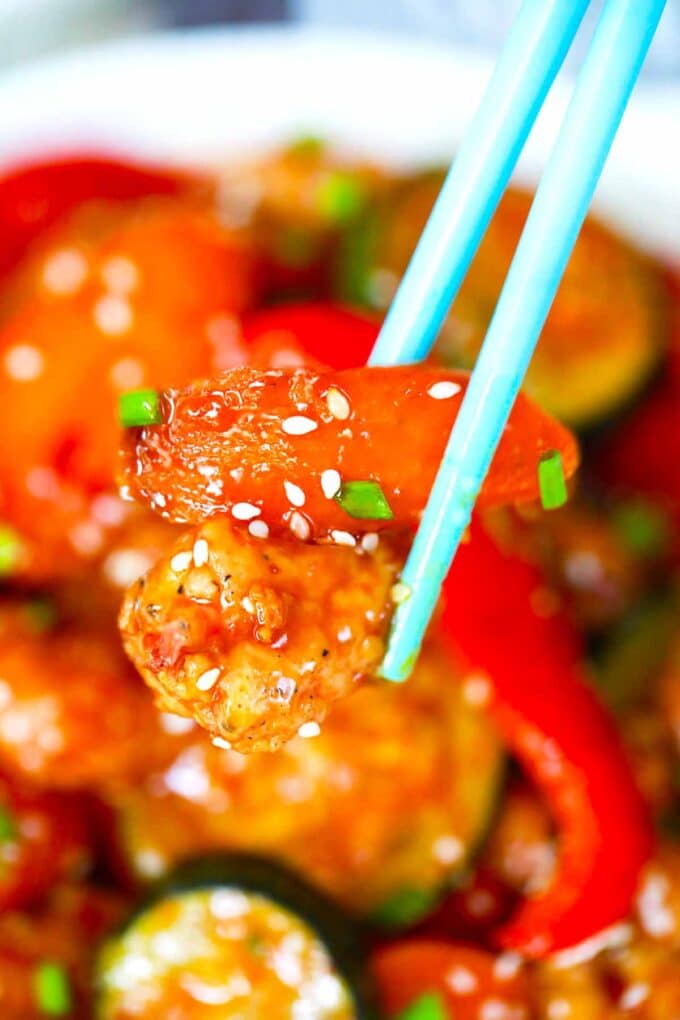
More Asian dishes you’ll love:
Loved this recipe? I’d love to hear from you! 💛 Leave a 5-star rating ⭐️ in the recipe card below and share your thoughts in the comments – I read and appreciate every single one!
Let’s stay connected! Follow me on Facebook, Instagram, Pinterest, and YouTube for more delicious, sweet and savory recipes. Have a question? Ask in the comments, and I’ll be happy to help! 😊 with love Catalina!
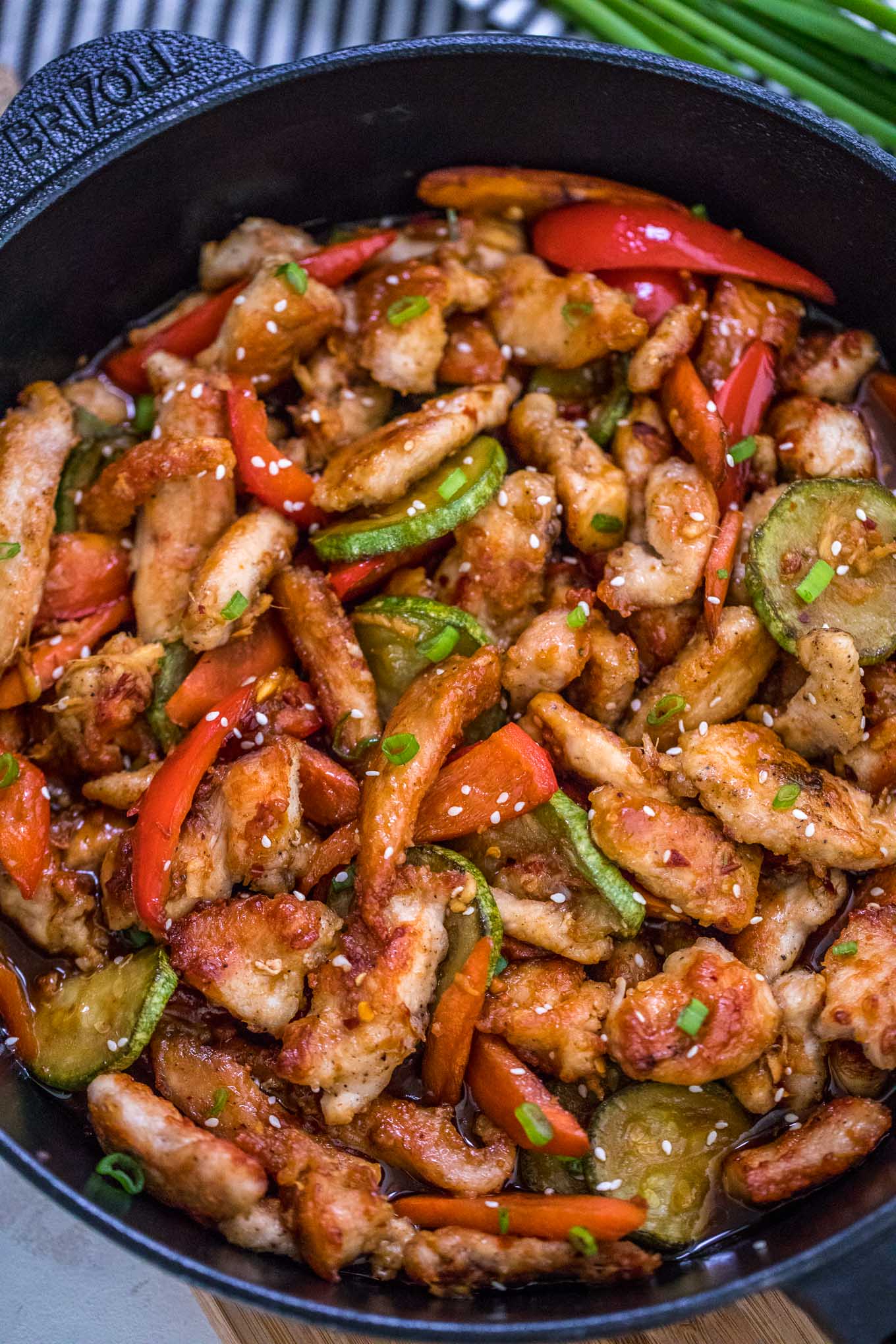
Hunan Chicken
Ingredients
- 2 large boneless chicken breasts cut into strips
- 1/4 cup cornstarch
- salt and pepper
- 2 tablespoons vegetable oil canola or peanut oil
- 1 red bell pepper sliced
- 1 zucchini cut into rounds
- 1 cup carrots sliced into rounds
- 3 chili peppers
- 1 tablespoon sprouted black beans optional
For the sauce:
- 1 tablespoon granulated sugar
- 1 teaspoon of rice wine
- 1 tablespoon cornstarch
- 4 cloves garlic minced
- 1 tablespoon fresh ginger minced
- 2 tablespoons chili paste such as Sambal Oelek
- 2 tablespoons oyster sauce
- 1/4 cup soy sauce
- 1/2 cup low sodium chicken broth
- 1/4 teaspoon red pepper flakes
- 1 teaspoon sesame oil optional, but great if you have any on hand
Garnish:
- Green Onions
- Sesame seeds
Instructions
Make the Hunan Sauce:
- Add all the ingredients for the sauce into a bowl and whisk until well combined.
Cook the meat:
- In a bowl add ¼ cup cornstarch and season with a little salt and pepper. Stir to combine with a fork. Add chicken pieces and toss to coat well.
- In a large pan over medium-high heat, add vegetable oil. Drop chicken pieces and cook until both sides are golden brown. Cook chicken in one layer, do not overcrowd. If needed cook in batches. Remove chicken from the pan and set aside.
Cook the Vegetables:
- Add a bit more vegetable oil to the pan and add vegetables and chili peppers, also add the sprouted beans. Cook for 7-8 minutes, stirring from time to time.
Combine meat and sauce:
- Return the chicken to the pan and also add the sauce. Stir and coat everything into the sauce and cook for 1-2 more minutes, until the sauce thickens.
Serve:
- Transfer to a plate or bowl and serve Hunan chicken with a side of white rice or noodles.
- Garnish with green onions and sesame seeds before serving.
Notes
No more dry chicken
Velveting is one of those techniques I learned along the way that completely changed how I cook stir-fry. It’s a simple method that helps keep the chicken tender and juicy while adding a light crisp texture on the outside. Traditionally, it involves coating the meat in egg white, oil, cornstarch, and sometimes a splash of rice wine before blanching it. But to keep things easy in this recipe, I just toss the raw chicken in cornstarch before browning it. It still gives that soft, velvety bite without all the extra steps, and it’s one of the reasons this dish turns out so good every time.More tips to consider:
- I like to make the sauce ahead and freeze it in small Ziploc bags. That way, I always have some ready to go when I need a quick dinner.
- To slice the chicken thinly and evenly, I freeze it for about 20 to 30 minutes first. It firms up just enough to make slicing easier.
- I always cook the chicken in batches to keep it from steaming. Giving it space in the pan helps it get that nice golden crust.




